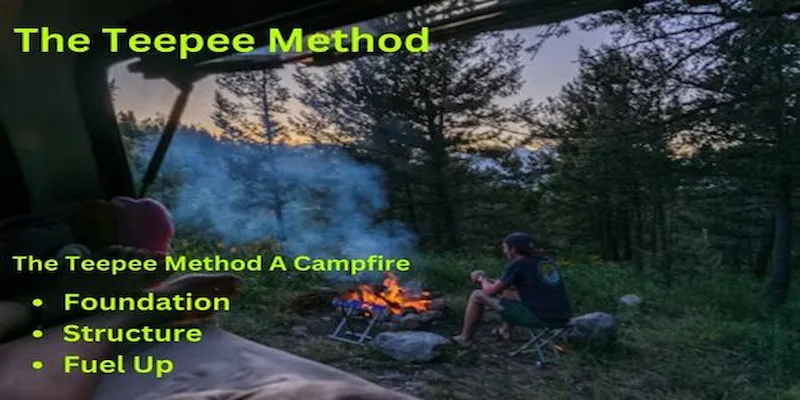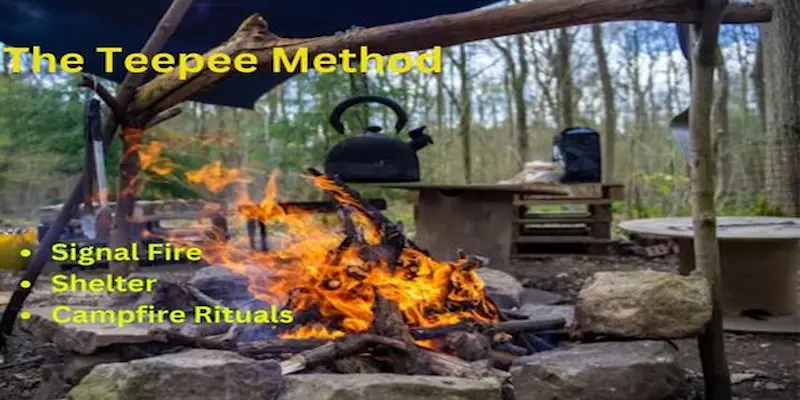Master the Teepee Method: Unlock Campfire Bliss in 7 Easy Steps (Guaranteed!)
Updated: 16 Feb 2024
264
The Teepee Method is a special way to build a campfire. This old technique, inspired by native homes, is more than just a way to make a fire. It’s like a tradition that makes your outdoor adventure even better. This Teepee Method, paying homage to the iconic Indigenous dwellings, goes beyond being a simple fire-building technique—it encapsulates a rich cultural legacy and offers a myriad of advantages for those who relish the great outdoors.
In this guide, we’ll go step by step, from making the base to lighting the fire, and we’ll explore why this Teepee Method is so cool. We’ll talk about its history, how it can help in emergencies, and why it’s great for creating fun campfire moments.
And guess what? We’ll also see how it fits into modern camping, why it’s good for the environment, and what’s good and not-so-good about it. Whether you’re a camping pro or just getting started, let’s celebrate that Teepee Method together—a way of making a fire that connects us to the past and brings joy to outdoor living.
Basics of the Teepee Method
1. Foundation
Imagine the beginning of your campfire as a canvas, where a bed of dry tinder is carefully laid out. Whether it’s leaves, bark, or specialized camping store options, this foundation sets the stage for the warmth that will soon envelop your campsite.
2. Structure
Craftsmanship comes into play as you lean small sticks against each other, creating a small architectural marvel. The result? A tent-like formation, strategically designed with an opening for optimal airflow, resembling the iconic original housing that inspired the technique.

3. Fuel Up
The symphony of fire-building begins as larger kindling and firewood are gradually introduced. This is similar to arranging a performance, maintaining the cone shape as you build, with each piece contributing to the increase of flames that will dance in the night.
4. Light it Up
Finally, the grand finale. catch fire the tinder nestled within the teepee, and witness the flames gracefully rise, turning your campsite into a haven of warmth and friendship.
Historical Significance
Indigenous Inspiration
Beyond its practical applications, this technique draws inspiration from the original design of traditional teepees. They were homes for various original groups in North America, testifying to their adaptability and efficiency in providing both shelter and warmth during journeys.
Simple & Effective
As time unfolded, the Teepee strategy found its place in the stories of early explorers, settlers, and eventually, modern recreational campers. Its simplicity and reliance on locally available materials ensured its widespread adoption, becoming a symbol of resourcefulness and outdoor camping.
Adaptability
This strategy isn’t bound by inflexibility; it’s a canvas waiting for your creative touch. Adjust the size and type of wood based on your desired heat and cooking aspirations, showcasing its versatility as a dynamic fire-building approach during camping.
Symbol of Tradition
Beyond its functional aspects, this approach stands as a symbol of tradition and connection to nature. During camping, adopting this technique is akin to participating in a ceremony that has been passed down through generations, fostering a sense of continuity and respect for the environment.
Beyond the Fire
1. Signal Fire
In unforeseen emergencies, the towering flames of the teepee can transform into a beacon, cutting through the darkness and attracting attention from in the distance. It’s a symbol of hope and a call for assistance for campers in camping.

2. Shelter
While the Teepee framework is primarily a fire-building technique, its design unintentionally offers a degree of wind and rain protection. In the unpredictability of nature, this adaptability can be a welcome friend.
3. Campfire Rituals
Beyond the practical advantages, this unique method becomes a ritual, a communal experience shared by those gathered around the fire. In campfire, the dance of flames becomes a narrator, weaving tales of past adventures creating lasting memories, and making your camping more memorable.
Remember
Responsible fire safety is non-negotiable when employing the Teepee Method. During camping, clear the area of garbage, have water or sand within arm’s reach for extinguishing and ensure the fire is not just dying but completely extinguished before leaving.
Incorporating the Teepee Method into Modern Camping
Educational Outreach
Modern camping isn’t just about survival; it’s about understanding and appreciating the techniques that have paved the way. Educational initiatives can focus on this effective methodology, not just as a skill but as a cultural bridge, connecting campers to the history of outdoor living.
Sustainable Camping Practices
As the importance of sustainability grows, this innovative technique aligns like a dream with eco-friendly camping. The controlled burning and efficient use of fuel make it a choice that resonates with the principles of Leave No Trace.
Community Building
Encouraging the use of the Teepee Method in camping communities fosters a sense of shared knowledge and camaraderie. Workshops, storytelling sessions around the campfire, and collaborative fire-building experiences can bring campers closer and create lasting connections.
Pros and Cons of the Teepee Technique for Campfire Building
The pros and cons of using this methodology for campfire building during camping are given below.
| Pros of Using the Teepee Method: |
|---|
|
| Cons of Using the Teepee Method: |
|---|
|
This distinct approach offers an efficient and traditional approach to campfire building, with its unique advantages and challenges in camping. Campers should weigh these pros and cons based on their experience level, the camping environment, and specific needs to determine if the Teepee Method aligns with their preferences and objectives.
FAQs
What is the Teepee Method?
This Methodology is a classic campfire-building technique named after the traditional Indigenous dwellings. It involves arranging small sticks in a conical shape over a bed of dry tinder, resembling the iconic teepee structure.
How do I construct a Teepee fire?
Start by creating a foundation of dry tinder, then lean small sticks against each other in a cone shape, leaving an opening for airflow. Gradually add larger kindling and firewood while maintaining the teepee structure. Ignite the tinder, and the fire will blossom within the cone.
Why is it called the Teepee Method?
The method draws inspiration from the conical shape of traditional teepees, the dwellings used by various Indigenous groups. The campfire structure mimics this shape, paying homage to the historical and cultural significance of Indigenous nomadic lifestyles.
What are the advantages of using the Teepee Method?
The Teepee Method offers efficient ignition, concentrated heat, versatility in wood types and sizes, fuel economy, a connection to tradition, and the potential for a signal fire in emergencies.
Is the Teepee Method suitable for cooking?
Yes, this Framework is suitable for cooking. The concentrated heat within the teepee structure makes it ideal for preparing meals over an open flame. However, the conical shape may limit the available cooking space.
Can beginners use the Teepee Method?
While there might be a slight learning curve, The Teepee Concept is generally beginner-friendly. With some practice, beginners can master the technique of constructing and maintaining a teepee fire.
Conclusion
The Teepee Method isn’t just a technique; it’s a bridge connecting the past with the present, an art form that transforms a simple campfire into a cultural experience. As you practice this time-honored method, you’re not just kindling flames; you’re igniting a connection to tradition, nature, and the collective spirit of those who have camped under the stars throughout history. So, next time you gather around the campfire, remember this distinct approach—a timeless formal procedure that turns a simple fire into a permanent inheritance.
Please Write Your Comments